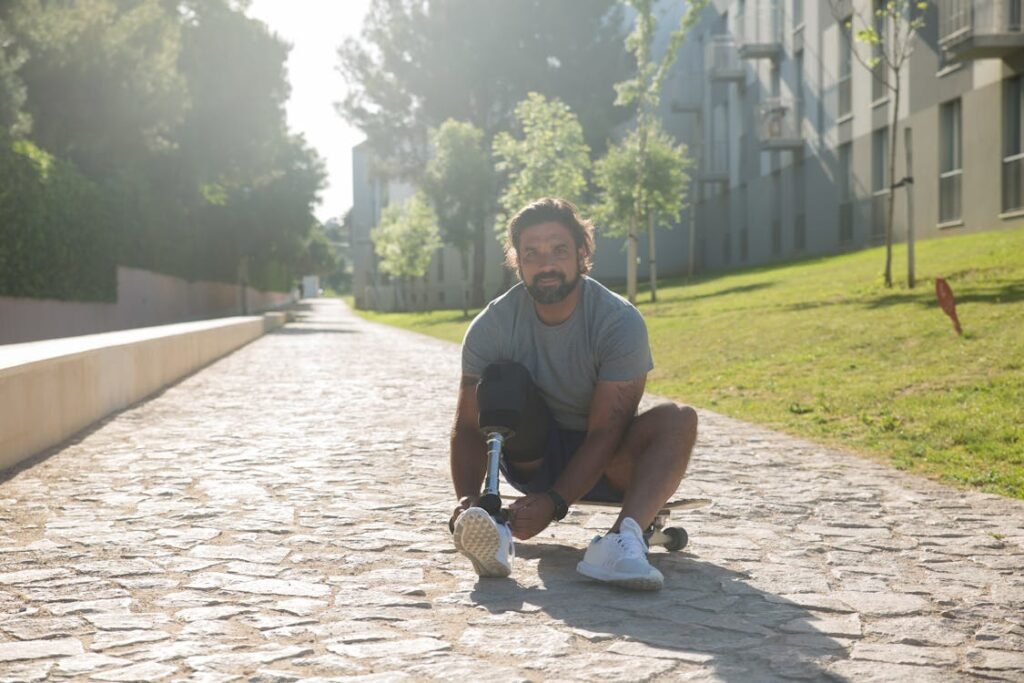After losing a limb, people often feel like their whole world has changed. There’s pain, shock, fear, and a lot of questions. One of the most important ones is about when to start using a prosthetic limb. This question might seem small, but the answer can change everything. The timing of prosthetic use affects not just walking or moving, but also how fast someone recovers—physically, emotionally, and even socially.
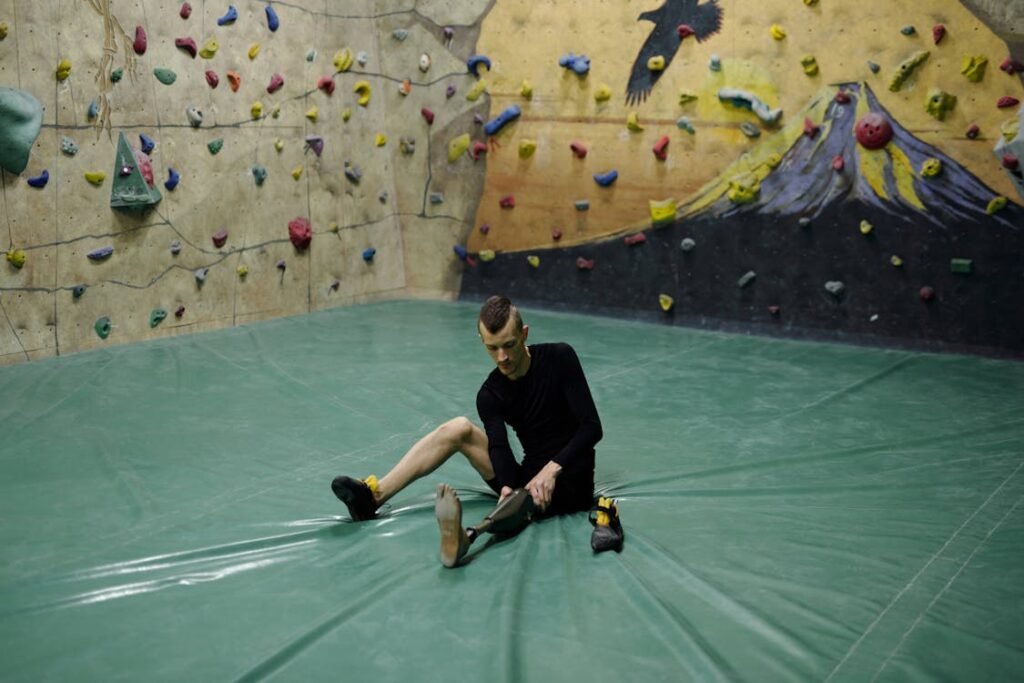
Understanding What “Early Prosthetic Use” Actually Means
The First Step in the Right Direction
Early prosthetic use doesn’t mean rushing someone into wearing a limb right after surgery. That would be unsafe. What it really means is starting the prosthetic journey as soon as the body is medically ready and the healing has reached a safe point. For some people, this can be within three to four weeks after surgery. For others, it might take a bit longer.
When a person is fitted early with a temporary or preparatory prosthetic, they begin to stand, balance, and take small steps. These movements start light but slowly build strength. It also sets the stage for using a permanent prosthesis later.
This phase isn’t about speed—it’s about smart recovery. The body learns, the brain adjusts, and the person starts feeling whole again. In this article, when we talk about “early use,” we mean this timely, controlled, medically-guided start that gives people the best chance to get back on their feet.
Why Waiting Too Long Can Slow You Down
The Invisible Cost of Delay
After surgery, your body wants to heal. But if you don’t use your muscles or joints for too long, they begin to weaken. This is true for everyone, no matter how healthy they were before the amputation. When people delay prosthetic use for too long, they face a few silent problems that grow over time.
The first issue is muscle loss. Without regular movement, muscles shrink. This makes walking later much harder because your body isn’t strong enough to support your weight properly. Even small tasks feel exhausting.
Another challenge is joint stiffness. If your knees or hips don’t move for weeks or months, they lose flexibility. This makes walking awkward or painful once a prosthetic is finally introduced. You might have to spend extra time in therapy just to regain what was lost.
Lastly, your brain and nervous system begin to forget what walking felt like. Movement patterns become unfamiliar. Balance is harder to find. Early prosthetic use helps keep these systems awake and alert.
Delaying use might feel safer at first, but in the long run, it often creates more work and more frustration.
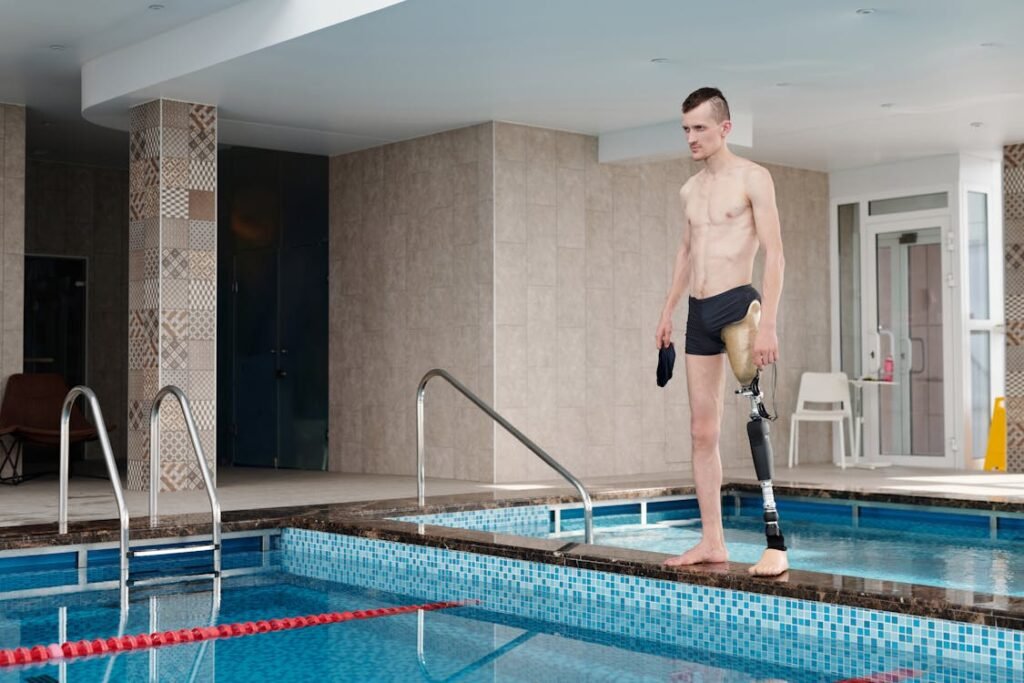
How Early Movement Changes the Healing Process
The Body Responds to Action
The body heals best when it’s active—gently, carefully, but steadily. When someone starts using a prosthesis early, they begin placing light pressure on the bones, muscles, and tissues. This pressure sends signals to the brain and the body that say, “We’re not done. We’re still using this.”
That signal matters. It encourages better blood flow, which brings nutrients to the healing site. It also helps reduce swelling and speeds up the return of normal skin tone and sensation. The stump begins to take shape in a way that’s better suited for a long-term prosthetic fit.
When you move, even a little, your body works smarter. Bones stay stronger. Muscles stay active. Skin becomes tougher and more flexible. Early use doesn’t just help you get used to your prosthetic—it helps your entire body heal faster.
This healing isn’t just physical. It’s also mental. Seeing yourself move again, even in a small way, can lift your mood and improve your outlook. You feel hopeful. That hope is healing too.
The Emotional Power of Getting Back on Your Feet
Why Standing Up Early Builds Confidence
After an amputation, people often go through a rollercoaster of emotions. There’s grief, anger, confusion, and sadness. These feelings are normal. But they can slow down recovery if not addressed.
Here’s where early prosthetic use makes a huge difference. The first time someone stands up—even if it’s just for a few seconds—they often cry. Not because it hurts, but because it feels like freedom. It feels like control.
That first step does something to the brain. It shifts the focus from what was lost to what’s possible. You begin to think, “If I can stand, maybe I can walk. And if I can walk, maybe I can run. Maybe I can work again. Travel. Dance. Live.”
That’s not just emotional fluff—it’s powerful mental fuel. And studies have shown that people who use prosthetics earlier tend to experience lower rates of depression and anxiety. They’re more engaged in their rehab programs. They’re more likely to return to work or school. And they often feel more in control of their lives.
Standing early tells the mind, “You’re not broken. You’re adapting.” That message is everything.
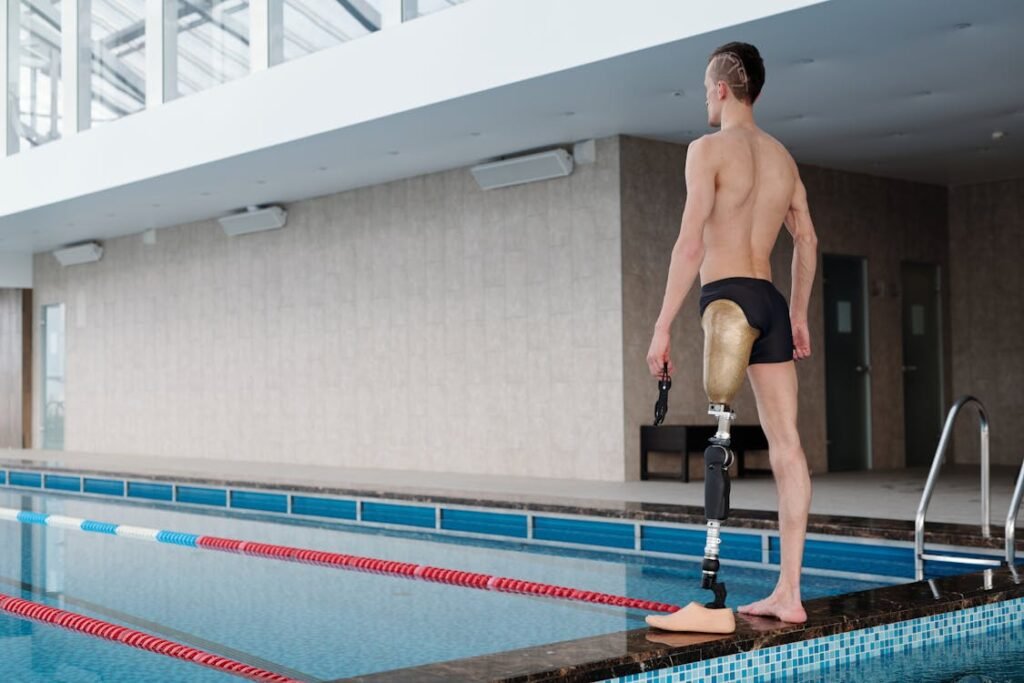
How Early Use Affects Physical Therapy Results
A Head Start Leads to Faster Progress
Physical therapy is a key part of recovery after amputation. But therapy works best when it’s combined with real movement, real effort, and real tools—like a prosthesis.
When someone starts therapy while already using a temporary prosthetic, the results multiply. They build strength faster. They develop balance more naturally. They get to practice real-world movements like sitting, standing, climbing, and walking from the very beginning.
Therapists love working with early prosthetic users because they can focus on functional rehab—helping patients do things they’ll actually do every day. This kind of therapy feels more rewarding, because patients see real progress, not just practice drills.
For delayed users, therapy can sometimes feel frustrating. The body isn’t ready. The limb isn’t involved. It becomes harder to stay motivated when everything feels like waiting.
Starting early gives you a rhythm. You move. You rest. You improve. You move again. It’s a loop that builds momentum and turns recovery into a habit—not a chore.
Early Fit and Long-Term Independence
One Small Step Leads to Big Freedom
The goal of prosthetic use isn’t just walking—it’s independence. It’s being able to go where you want, do what you need, and live how you choose. Early prosthetic use sets the tone for this freedom.
When someone learns to use a prosthetic early, they pick up habits that stay with them. They learn how to clean the limb. They understand pressure points. They can adjust their balance in public places like markets or buses. These skills come from experience—and experience comes from use.
People who start early tend to rely less on walking aids like crutches or walkers. They’re more confident in unfamiliar environments. They fall less. They recover from stumbles more quickly. And they often return to their jobs or routines months ahead of schedule.
This independence isn’t just practical. It’s emotional. It means you don’t always have to ask for help. You don’t feel like a burden. You feel capable. That feeling shapes every part of your day—from getting dressed to planning a holiday.
The earlier you start moving, the sooner you start living on your terms.

The Role of the Care Team in Early Prosthetic Success
How Support Changes Everything
No one recovers from amputation alone. Behind every successful prosthetic user is a team—a surgeon, a prosthetist, a physiotherapist, maybe a counselor, and often family or caregivers. This team is especially important when someone is using a prosthetic early.
Why? Because early use comes with frequent changes. The limb is still healing. The socket may need adjustments. Therapy must be carefully guided. Skin must be checked. All of this requires close, constant support.
When your team is involved early, they catch problems before they grow. They suggest improvements. They celebrate small wins. And they remind you that you’re not doing this alone.
Prosthetists, in particular, are key players. They don’t just build your limb—they teach you how to use it. They listen to your concerns. They make you feel heard. When they’re involved early, they create a relationship of trust that lasts for years.
Therapists guide your body. Prosthetists guide your equipment. Together, they make sure your journey is steady, safe, and successful.
How Early Prosthetic Use Impacts Children
Starting Early Builds Lifelong Confidence
When a child loses a limb, early prosthetic use becomes even more important. Children learn quickly. They adapt faster than adults. And they form habits that last for life.
Giving a child a prosthetic early helps them develop normal walking patterns. It prevents posture problems. It supports school activities, play, and social confidence. Most of all, it teaches them that their body is strong and capable—no matter what.
The prosthesis becomes part of their story, not a strange new object. They run, jump, and laugh with it. They see it as normal. And that attitude creates long-term emotional strength.
Parents play a big role here. They help with fittings, care routines, and encouragement. But the earlier a child uses a prosthetic, the less it feels like a “thing they have to wear.” It becomes just another tool—like shoes, glasses, or a backpack.
Early use helps children feel included. And inclusion builds resilience.
Technology and the Benefits of Early Integration
Learning With the Limb Makes Tech Easier
Modern prosthetics are more advanced than ever. From sensors to smart knees to AI-driven movement, the options are growing fast. But to benefit from these technologies, users need to feel comfortable with the basics. That’s where early use helps.
When someone starts using a prosthesis early, they also start learning how to sync devices, charge batteries, use apps, and understand features. These things become normal, not scary.
They also provide helpful feedback to their care team. “The knee doesn’t feel right when I sit.” “The foot feels stiff on slopes.” This kind of feedback is only possible when the person is actively using the limb.
Delayed users may get the same tech—but they often find it overwhelming. There’s too much to learn, too fast. They may miss out on features simply because they weren’t trained to use them well.
Early users, on the other hand, grow with their tech. And that growth makes a huge difference in how much freedom and control they gain from it.

How Early Prosthetic Use Helps Preserve Natural Walking Patterns
Timing Shapes the Way You Move Forever
One of the most overlooked aspects of early prosthetic use is how it influences walking mechanics. Walking is a highly coordinated action involving muscles, joints, and reflexes. After an amputation, the body has to relearn how to move. The longer that process is delayed, the more likely it is that someone will develop poor posture or uneven gait.
When someone begins prosthetic walking early—even with a temporary limb—their brain starts forming new connections right away. These neural pathways help recreate a rhythm that feels natural and balanced. The hips and shoulders move in harmony. The foot strikes the ground properly. The back stays straight.
If this relearning happens too late, the body may have already adopted compensations. People start leaning too much to one side. They swing their prosthetic leg awkwardly or avoid putting weight on it. These habits become hard to break later on and can lead to long-term issues like back pain, hip strain, or uneven wear on joints.
Early use keeps everything aligned. It helps the prosthetic feel like part of the body rather than a foreign object that must be controlled. This smooth integration makes every step more efficient and less tiring.
It’s like learning a language—start young, and fluency comes easily. Start late, and you’re always translating in your head. With prosthetics, early walking is the language of recovery.
The Impact of Early Prosthetic Use on Social Reintegration
Confidence in Public Starts With Confidence at Home
After amputation, people often feel uncomfortable going out in public. They’re not sure how others will react. They worry about stares, questions, or awkward situations. That’s a normal response—but one that becomes harder to overcome the longer someone stays isolated.
When prosthetic use begins early, people spend less time in this uncertain, waiting phase. They start moving through the world sooner. They build confidence at home, in therapy, and in small public spaces like clinics. From there, they take bigger steps—visiting the market, going to work, attending family events.
Every small outing adds courage. The person starts to feel more visible again—not as someone who’s missing a limb, but as someone who is adapting to life and participating fully.
In contrast, delayed users often miss this gentle ramp back into society. They wait so long that their absence becomes noticeable. Returning to public spaces feels like a grand reveal instead of a gradual return. That can bring anxiety or even shame, even though it shouldn’t.
Early users also tend to talk more openly about their prosthetics. They answer questions more easily. They help educate their peers. This creates a ripple effect—normalizing prosthetic use for others and reducing social stigma.
So yes, early prosthetic use improves mobility. But it also restores something just as powerful: presence. It brings people back into the world, sooner and with more strength.
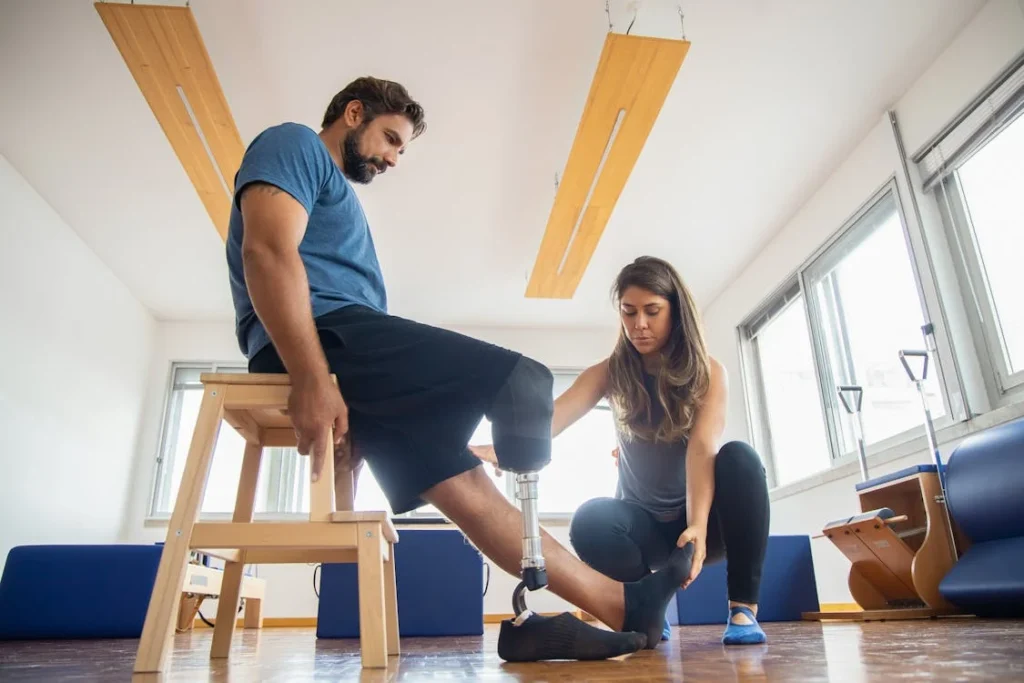
Skin Health and Comfort: How Early Use Builds Resilience
Your Skin Needs Practice Too
The skin on your residual limb is not immediately ready to handle a prosthetic socket. It’s soft, sensitive, and still healing. But like every part of the body, it adapts over time—and the earlier that process starts, the better the skin performs.
With early use, even in short sessions, the skin begins to toughen gently. It learns how to manage pressure, moisture, and friction. You figure out early what kind of liner works best. You learn how to spot red marks before they become blisters. You build awareness of your own body.
This early adaptation prevents long-term issues. Chronic wounds, pressure sores, or skin infections often come from neglect or delayed learning. But if you start using your prosthetic early, you catch these problems before they grow. You also become more comfortable with daily routines like cleaning, checking for irritation, and using creams or wraps if needed.
Skin resilience is not just physical—it’s knowledge. The earlier you start, the more skilled and aware you become. And that pays off every single day you wear your prosthesis.
The Psychological Timing Window: Why the Brain Needs Early Wins
Healing the Mind While Healing the Body
There is something known in rehabilitation as the “psychological timing window.” This refers to the period right after trauma when the brain is most open to change. It’s a unique phase—somewhere between shock and acceptance—where a person is highly aware, highly motivated, and actively forming new beliefs about what their future might look like.
Using a prosthetic during this window can create a positive feedback loop. You take a few steps. You feel hopeful. That hope gives you energy. That energy makes you work harder in therapy. You get stronger. You walk more. The loop continues.
If this window closes without progress, the opposite can happen. The brain starts to believe that movement isn’t possible. That the body is too broken. That change is too hard. These thoughts stick. And they’re much harder to unlearn later.
Early prosthetic use isn’t just a physical strategy—it’s a psychological intervention. It interrupts the belief that recovery is out of reach. It offers proof that progress is possible. And that proof builds identity. Instead of seeing yourself as a patient, you start seeing yourself as a person in motion again.
That shift in mindset might be the most important change of all.
Family Dynamics and Early Use: Restoring Roles and Routines
Rebuilding Relationships Through Movement
After an amputation, family roles often shift. Someone who used to be independent now needs help getting out of bed, bathing, or even eating. This change affects not just the amputee, but also their loved ones. It brings stress, confusion, and emotional strain.
Early prosthetic use helps ease this pressure. When a person begins to walk again—even if it’s just across a room—it sends a strong signal to everyone in the house: “I’m coming back.” That signal restores hope and begins the process of returning to old roles.
Parents feel less worried. Partners feel more connected. Children feel reassured. The home starts to feel balanced again.
Without early use, this return takes longer. Caregivers become tired. The person using the prosthetic may feel like a burden. Frustrations rise, even with love present. That emotional weight slows down recovery for everyone involved.
But when early movement returns, so does dignity. The person can dress themselves. Make tea. Open the door. These small acts ripple through the home and change the energy completely.
Rehabilitation isn’t just about limbs—it’s about life. And life is shared. Early prosthetic use restores routines, trust, and peace at home.
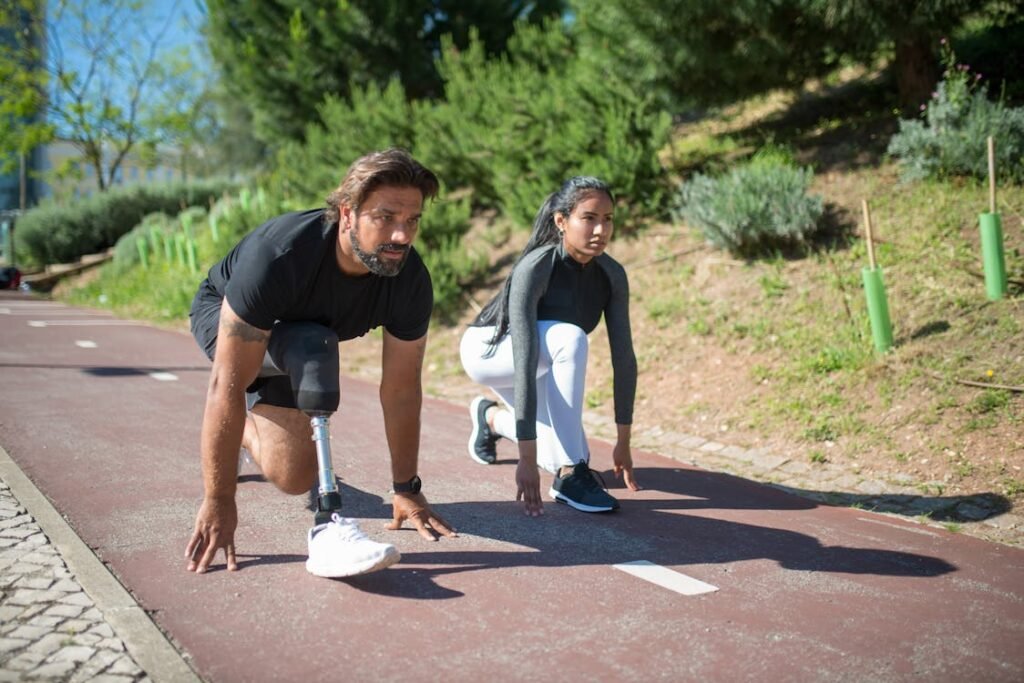
Mobility and Safety: Preventing Accidents Before They Happen
Movement as a Shield, Not a Risk
Some people delay prosthetic use because they’re afraid of falling. That fear is valid—falling with a prosthesis can be dangerous. But what’s less understood is that avoiding prosthetic use can also raise the risk of accidents.
Here’s why: when someone relies too long on wheelchairs, walkers, or hopping on one leg, their body weakens unevenly. They become more unsteady. Their reflexes slow. Their balance suffers. So even small tasks like moving from bed to chair can result in a fall.
Early prosthetic use, when guided by a therapist, trains the body in safe, stable movement. You learn how to shift weight, how to pause before turning, how to use grab bars and handrails effectively. You also strengthen the exact muscles needed to catch yourself if you trip.
Over time, these skills create confidence. And confident movement is safer movement.
The goal isn’t to remove risk entirely—that’s not possible. The goal is to teach the body how to respond well to challenges. That training begins with early use. And it saves many from preventable injuries down the road.
Real-World Adaptation: How Early Users Navigate Public Environments
From Hallways to Highways
Hospitals and rehab centers are designed for healing. But the real world isn’t. There are stairs without railings, elevators that take forever, slippery tiles, uneven roads, and crowds that don’t always make space. To thrive, a prosthetic user has to be ready for these everyday challenges.
Early use gives you practice in real environments. As soon as the prosthetist and therapist give the green light, you can start testing movement in hallways, gardens, waiting rooms, or even grocery stores. Each space becomes a mini lesson. How do you pivot in tight areas? How do you manage curbs? How do you step into a rickshaw?
These lessons are best learned early and gradually. If they’re delayed, the learning curve becomes steep and intimidating. The world feels like a minefield instead of a playground.
Early users also learn how to adapt quickly. They become good at problem-solving, like how to move safely during rain or what shoes provide the best support. These skills build independence and allow people to explore the world with fewer limits.
You don’t want your first trip outside to feel like a test. With early use, every outing becomes a training ground for freedom.
Employment, Productivity, and Early Return to Work
Getting Back to Purpose
Work is more than a paycheck. It’s identity, contribution, and routine. When someone loses a limb, their connection to work often feels broken. They may wonder, “Can I still do my job? Will my coworkers accept me? Am I still useful?”
Early prosthetic use helps answer these questions sooner. It shows that mobility is returning. It tells employers that the recovery is progressing. It gives the person confidence to plan—not just survive.
Many early users return to work faster than delayed users. They may start part-time, with light duties. But the return itself is a victory. It proves to the mind that normal life isn’t over—it’s adapting.
For self-employed individuals, early movement helps them manage their business. Farmers return to their land. Shopkeepers return to their counters. Artists return to their craft.
And for those not in formal work, productivity still matters. They return to family roles, hobbies, volunteering, or daily routines. They stop feeling stuck. They start feeling valuable again.
conclusion
There is no one-size-fits-all answer when it comes to prosthetic timing. But again and again, the research—and the real stories—point to the same truth: the earlier you begin, the faster you grow. Early prosthetic use supports healing, movement, confidence, independence, and long-term quality of life. It reduces complications, strengthens your body, and lifts your spirit.
At Robobionics, we believe in starting strong. We work closely with doctors, therapists, and patients to ensure the first steps happen at the right time—with the right tools and the right support. Because you deserve more than just a prosthetic. You deserve a full, free, fearless life. And that life begins the moment you decide to stand again.



